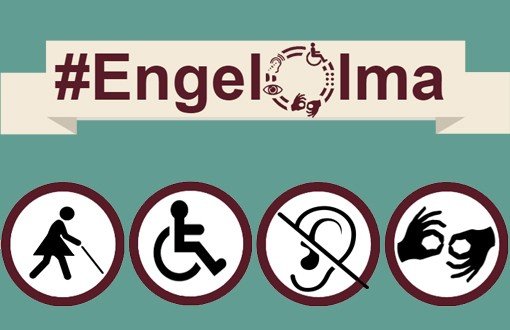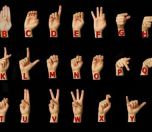Today is the International Day for Persons with Disabilities.
According to the Census and Housing Study 2011, 6,6% of the whole population has at least one disability. This study does not include chronic illnesses.
According to the Research on Persons with Disabilities 2002, percentage of persons with disabilities is 12,29. Persons having impaired hearing, visual, speech and language disorders and mental disabilities are at the rate of 2.58% whereas the percentage of persons having chronic illnesses is 9,7%.
In short, according to these two studies, the number of persons with disabilities is estimated to be between five and nine million in Turkey. Yet it impossible to see persons with disabilities on the streets represented with this percentage within the population.
Note that there is not just a single form of disability. Such as impaired hearing, orthopedic, visual and mental disabilities...Hence every group with certain disabilities have different problems.
We will try to present an overall picture of the situation through five topics in which we have summed up the problems without going into great detail.
The data we have used refer to Disabled Rights Monitoring Report From Regulation to Practice
1-) Discrimination
The approach of society and decision makers to persons with disabilities is not rights-based but help-based. This perspective built on mercy and compassion individualizes the problems and reduces the issue to helping instead of solving the problems with a rights-based approach. News about persons with disabilities on the media are also produced mainly with this perspective. Thus discrimination lies beneath all the trouble as a matter of fact.
2-) Accessibility
High pavements without plattform, perceivable surfaces paved before trees, nonfunctioning sound systems in busses...etc.
The leading legislation on accessibility in Turkey has been introduced in July 2005 under the name Persons with Disabilities Act.
According to the act, public domain, buildings and public transportation vehicles needed to be made accessible for persons with disabilities within ten years (extension period included). On July 7, 2015 the provided time expired yet no progress was made in the passing 10 years.
In 2012, as the required time was extended, Accessibility Monitoring and Inspection Commissions have been established yet no penalty has been imposed until today.According to statistics, 81,40% of 285.871 pedestrian roads in Turkey have no perceivable platform implementation.
58,98% of 26.463 urban transportation vehicles in service in 51 provinces in Turkey have no platform or lift. 73,08% of these have no audible and 70,40% no visual warning systems.
Only 32,51% of 29.795 public buildings have elevators, 24,68% have suitable bathrooms and 0,23% have inductive loop systems.
In public buildings staff members with body language knowledge is limited to 15%. 95,24% of web pages of state institutions and organizations are not suitable for persons with visual disabilities and 92,86% for persons with hearing disabilities.
3-) Education
According to data from the Council of Higher Education (YÖK) by November 2014 only 13,887 of 6,025,539 university students have disabilities, that is to say 23 per 10,000.
61,2% of students with disabilities are men and 38,7 are women. Women are more disadvantaged. Only 381 graduate and 45 postgraduate students have disabilities. In Turkey there are only 200 academicians with disabilities.
Within the system of inclusive education there are massive deficiencies to enable students with disabilities to get education together with their fellows without disabilities, both in terms of academical and physical accessibility as well as staff member capacity. Violation by fellows is another important issue.
In 2014, 182,917 students get inclusive education within the 12 years of compulsory education system. Only 56,560 students get education in special teaching institutions. In relation to the total number of students with disabilities, the number of students getting education in special institutions would have to be around 400,000-500,000.
The rapid increase in the number of Special Education and Rehabilitation Centers which charge a contribution fee from the state per student and are difficult to monitor is suspicious.
Teachers for special education are few in number. Other teachers on the other side do also have no training in communication with students with disabilities.
Within the media watch in 2014, in 106 reports it was detected that students with disabilities have been exposed to violence in their educational environment.
4-) Employment
In Turkey the mandatory employment of persons with disorders is in the public sector is 3% for employees and 4% for workers and in the private sector it is 3%.
According to data from State Planning Organization by November 2015, in the public sector there is still a gap of 22,553 persons with disabilities who should have been employed according to the mandatory employment regulations to meet the required quota. The number lies by 24.349 for public and private sectors.
Employers who do not engage employees with disabilities have to pay a 1,700 TL fine per month and employee.
However still a system of charging penalty payments is preferred to making workplaces accessible, stopping discriminations, eliminating occupational and educational deficiencies and this way employing persons with disabilities as these are perceived as a disturbance in the workplace. They are discriminated and mobbed in various ways.
5-) Health
A significant part of the vital needs of persons with disabilities such as rehabilitation services, ancillary equipment and medical consumables are not compensated by the state or the compensation is insufficient.
Access to health facilities is still inadequate. Lack of staff members and especially doctors with body language knowledge cause serious problems. 62,86% of 385 hospitals which responded to the request of information and among 469 hospitals in total have no staff members with body language knowledge.
In Turkey, there are only 14 physical therapy and rehabilitation hospitals, nine psychiatric hospitals and 96 community mental health centers.
Community based rehabilitation services have still not reached the desired prevalence. Psychiatric Hospitals which are characterized as “depot hospitals” do not fulfill their duties to rehabilitate and treat persons with disabilities.
Health board records of persons with disabilities continues to be a problematical field. There is no system which can meet all the needs at a stretch. Conditions of monthly payment for domiciliary care and introducing disability salary have been associated with the status of other individuals living in the same household and therefore been made complicated. (NV / DG)
Click here to read the article in Turkish.











